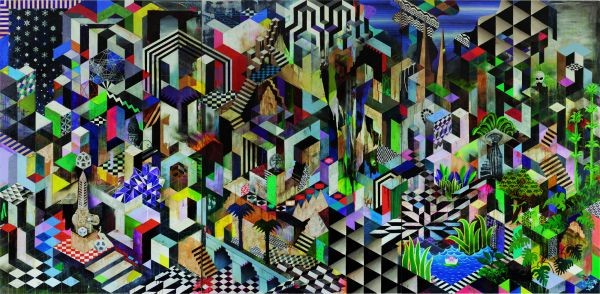Michael Conrads
06 Sep - 19 Oct 2013

© Michael Conrads
Another fool on the hill, 2013
Oil, ,lacquer, shellack, paper, oil pastel, pigment, bitumen, watercolour on canvas
250 x 540 cm (three parts)
Photo: Tim Schröder
Another fool on the hill, 2013
Oil, ,lacquer, shellack, paper, oil pastel, pigment, bitumen, watercolour on canvas
250 x 540 cm (three parts)
Photo: Tim Schröder
MICHAEL CONRADS
Loreto
6 September – 19 October 2013
"Day after day, alone on a hill..."
There had been signs of an imminent eruption for some time, such as in the works “La Gran Cuidad” (2007) and “Tropic of Cancer” (2012). Not only in his choice of motifs but also in his approach to painting, the artist had just about made balancing and exploiting the creative tension between his own conceptual rules and the dynamic process of evolving and breaking them a stylistic feature of his art.
With his latest large-scale painting, “Another Fool on the Hill”, Michael Conrads once again takes us on a journey, this time on a Grand Tour to ancient, universal and fantastic sites. He leads us through unfathomable labyrinths and seemingly impenetrable microcosms. He shows us an immediately entrancing panorama which we gaze at in amazement in the same way we gaze at and observe natural landscapes.
The painting offers an unusual perspective, encompassing not only a panoramic view but also a bird’s-eye and a worm’s-eye view. Where previously urban structures – subjective experiences of big-city scenes – seemed absorbed into Conrads’ abstract pictures, this new work includes close-up views and detail studies – an almost romantic concept. From his previous works, we know that Conrads likes to get disoriented, break up homogenous units and confuse with dense layering. He recycles his pictures, cuts them up, and makes the painterly process of constant alteration visible. He works with construction and deconstruction, elaboration and laissez-faire smudges of colour.
Like Conrads’ previous abstract paintings, this work, too, deals with complex painterly questions and problems, such as motif construction, isometric plane composition, inherent framework structures and colour composition. It experiments with painting media, the many possibilities for picture form, rhythm, and limiting and delimiting the picture format by means of all-over structures. In a way, “Another Fool on the Hill” remains a patchwork painting, on a semantic as well as a methodical level. But there is also a completely new element. It derives not only from the artist’s distinct embrace of, or return to, the representational, but above all from the complex inclusion of new systems of reference and symbols, no longer concentrating solely on Western modern and postmodern avant-garde art. A sign of this is the title Conrads chose for the picture. Back in 1999, Daniel Richter referred to the same Beatles song with his painting of almost the same name, which marked the artist’s explosive leap into narrative representational painting.
Sabine Maria Schmidt
Translation Charlotte Kreutzmüller
Loreto
6 September – 19 October 2013
"Day after day, alone on a hill..."
There had been signs of an imminent eruption for some time, such as in the works “La Gran Cuidad” (2007) and “Tropic of Cancer” (2012). Not only in his choice of motifs but also in his approach to painting, the artist had just about made balancing and exploiting the creative tension between his own conceptual rules and the dynamic process of evolving and breaking them a stylistic feature of his art.
With his latest large-scale painting, “Another Fool on the Hill”, Michael Conrads once again takes us on a journey, this time on a Grand Tour to ancient, universal and fantastic sites. He leads us through unfathomable labyrinths and seemingly impenetrable microcosms. He shows us an immediately entrancing panorama which we gaze at in amazement in the same way we gaze at and observe natural landscapes.
The painting offers an unusual perspective, encompassing not only a panoramic view but also a bird’s-eye and a worm’s-eye view. Where previously urban structures – subjective experiences of big-city scenes – seemed absorbed into Conrads’ abstract pictures, this new work includes close-up views and detail studies – an almost romantic concept. From his previous works, we know that Conrads likes to get disoriented, break up homogenous units and confuse with dense layering. He recycles his pictures, cuts them up, and makes the painterly process of constant alteration visible. He works with construction and deconstruction, elaboration and laissez-faire smudges of colour.
Like Conrads’ previous abstract paintings, this work, too, deals with complex painterly questions and problems, such as motif construction, isometric plane composition, inherent framework structures and colour composition. It experiments with painting media, the many possibilities for picture form, rhythm, and limiting and delimiting the picture format by means of all-over structures. In a way, “Another Fool on the Hill” remains a patchwork painting, on a semantic as well as a methodical level. But there is also a completely new element. It derives not only from the artist’s distinct embrace of, or return to, the representational, but above all from the complex inclusion of new systems of reference and symbols, no longer concentrating solely on Western modern and postmodern avant-garde art. A sign of this is the title Conrads chose for the picture. Back in 1999, Daniel Richter referred to the same Beatles song with his painting of almost the same name, which marked the artist’s explosive leap into narrative representational painting.
Sabine Maria Schmidt
Translation Charlotte Kreutzmüller
